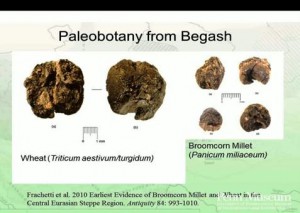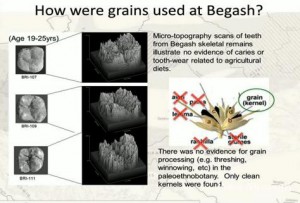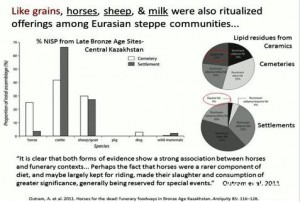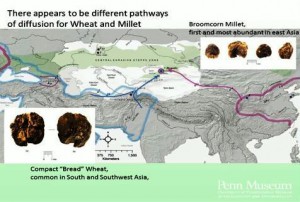- Sustainable fashion, darling.
- “The world’s leading international researchers will review the history of climate change, appraise the current state of the science and identify adaptations for the future.” It says here.
- Fiji suddenly discovers yams.
- Genebank romance in Durango. Well, that felt good.
- Animal Genetic Resources vol 8 is out.
- Locavores go crazy on Guam.
- Cocoa origins celebrated. And why not?
- Seems like every few months there’s something else on how those southern Iraq marshes are being brought back to life. But what I really want to know, and nobody is saying, is if there are any crop wild relatives there.
Nibbles: Cassava, Biopiracy, Neolithic, Potato history, Pollinator conservation
- The pros and cons of biofortified cassava rehearsed for the nth time.
- Scientists accused of biopiracy for the nth time.
- nth genetic study of ancient farmers. Men moved, in a nutshell, women not so much.
- Traditional healers: nth example of a group hard hit by climate change.
- In all above cases, n is a large positive integer.
- Potatoes responsible for about 25% of Old World population increase between 1700 and 1900. Nice maths.
- Learn how to conserve pollinators. If you’re in Rhode Island. But there is an online Pollinator Conservation Resource Center with lots of resources.
Using ancient grains to remap perceptions of Central Asia
The Silk Road Symposium held at the Penn Museum in March 2011 was clearly quite a get-together, judging by the personalities involved. Some of the presentations are on Youtube, including one by Dr Michael Frachetti on “Seeds for the Soul: East/West Diffusion of Domesticated Grains,” which has been picked up and discussed by Dienekes on his blog. It’s really worth listening to the whole talk, even at 45 minutes, but in case you don’t have the time, here are the main points.
 Dr Frachetti excavated at a place called Begash in Uzbekistan. This is a site which goes back to at least 2500 BC and was used by nomadic pastoralists for many centuries. The dig came up with the earliest evidence of wheat and broomcorn millet in Inner Asia, dating back to about 2200 BC. At left is what the seeds they found look like (click to enlarge).
Dr Frachetti excavated at a place called Begash in Uzbekistan. This is a site which goes back to at least 2500 BC and was used by nomadic pastoralists for many centuries. The dig came up with the earliest evidence of wheat and broomcorn millet in Inner Asia, dating back to about 2200 BC. At left is what the seeds they found look like (click to enlarge).
 But here’s the thing. There’s no evidence that the people living at Begash at the time actually ate these things. 1 Their teeth just don’t look like the teeth of people who have a lot of cereals in their diet. Basically, no cavities. And there was no evidence of processing either. So what was happening?
But here’s the thing. There’s no evidence that the people living at Begash at the time actually ate these things. 1 Their teeth just don’t look like the teeth of people who have a lot of cereals in their diet. Basically, no cavities. And there was no evidence of processing either. So what was happening?
 The seeds were recovered from a very particular context — a cremation burial. And only in that context. Along, incidentally, with horse remains. Both the cereals and horses were in fact ritual commodities, the excavators think. Not stuff to be consumed every day, but rather exotic commodities to be wheeled out on very special occasions to make an impression. As Dienekes points out, using wheat for funerary offerings goes on still.
The seeds were recovered from a very particular context — a cremation burial. And only in that context. Along, incidentally, with horse remains. Both the cereals and horses were in fact ritual commodities, the excavators think. Not stuff to be consumed every day, but rather exotic commodities to be wheeled out on very special occasions to make an impression. As Dienekes points out, using wheat for funerary offerings goes on still.
 Where did the cereals come from? To cut a long story short, the wheat from the west and the Panicum millet from the east. 2 Which is the reason why Dr Frachetti thinks we need to remap our thinking about Central Asia. It’s not so much that the people who inhabited these regions were peripheral to the great Bronze Age civilizations, but rather (or, perhaps, also) that they were the link between them.
Where did the cereals come from? To cut a long story short, the wheat from the west and the Panicum millet from the east. 2 Which is the reason why Dr Frachetti thinks we need to remap our thinking about Central Asia. It’s not so much that the people who inhabited these regions were peripheral to the great Bronze Age civilizations, but rather (or, perhaps, also) that they were the link between them.
Brainfood: Cabbages, Crops in Darfur, Sowing dates, People and biodiversity, Honeybees, Rhizobium, Figs, Urban ag, Wild olives, Ancient textiles, Ducks, Wheat introgression, Food citizenship, Crop models, Trifolium, Variety choice
- Genetic diversity of Brassica oleracea var. capitata gene bank accessions assessed by AFLP. Czech genebank; subgroups reflected place of origin.
- Optimizing the cropping mix in North Darfur State, Sudan. A study of Umkdada district. “…the results of the model were different from the real practices of the farmers.” Oh dear. To improve the fit, schoolboys should work in the fields more. And crops should fetch more. The dismal science indeed.
- Climate-driven simulation of global crop sowing dates. Ok, this model works. You can predict sowing dates under rainfed conditions for various annual crops from climatic conditions. Not entirely sure why you would want to, though.
- Exploring some of the myths of land use change: Can rural to urban migration drive declines in biodiversity? Yes, counter-intuitively, at least in the forests of Mexico’s southwestern highlands. More from Conservation Magazine.
- Pollination services in the UK: How important are honeybees? Quite a bit, but maybe not as much as previously thought. It’s the wild bees, stupid!
- Genetic diversity and symbiotic effectiveness of rhizobia isolated from root nodules of Phaseolus vulgaris L. grown in soils of Iran. It is high, and it varies, respectively.
- Interspecific hybridization of fig (Ficus carica L.) and Ficus erecta Thunb., a source of Ceratocystis canker resistance. It’s a breakthrough!
- Exploring the diversity of urban and peri-urban agricultural systems in Sudano-Sahelian West Africa: An attempt towards a regional typology. There are 6 types. Not 5; not 7. On this one, the journey is more interesting than the destination.
- Variability of wild olives (Olea europaea subsp. europaea var. sylvestris) analyzed by agro-morphological traits and SSR markers. There’s a lot of variabzzzzzzzzzz…
- Hemp in ancient rope and fabric from the Christmas Cave in Israel: Talmudic background and DNA sequence identification. Mainly flax, but some hemp, from both Roman and Chalcolithic periods. But can you smoke it?
- Modelling the distribution of domestic ducks in Monsoon Asia. Low resolution data, plus fancy modelling, can be used to get pretty good high resolution predictions.
- Gene flow between wheat and wild relatives: empirical evidence from Aegilops geniculata, Ae. neglecta and Ae. triuncialis. It happens, a lot.
- Toward food system sustainability through school food system change: Think&EatGreen@School and the making of a community-university research alliance. Food citizenship?
- Simulation of winter wheat yield and its variability in different climates of Europe: A comparison of eight crop growth models. Big differences among models, so best thing to do is to use the mean of all of them.
- The potential of plant viruses to promote genotypic diversity via genotype × environment interactions. The negative effect of White Clover Mosaic Virus (WCMV) infection on performance differs from white clover genotype to genotypes, which means differential selection, which means negative frequency-dependent selection in host populations, which means diversity. Via.
- Amplifying the benefits of agroecology by using the right cultivars. Why should we summarize, when an author has already done so?
Nibbles: Spatial data, poverty, Livestock diseases, Romania, Cultural diversity, Iraqi marshes, Citizen science , Biohappiness, Beer!
- The CGIAR spatial crowd get it together? Not holding my breath.
- So tell me about that biodiversity-poverty link. Well, more research is, ahem, needed. Wet, for want of a better word.
- All the different kinds of “spots” for livestock diseases. How did they cope with the poor data? And have the various hotspots and coldspots been considered in drawing up the new research priorities for livestock?
- UNDP stumps up $4 million to plan biodiversity management in Romania. Including agrobiodiversity? Not holding my breath.
- A socio-economic impact analysis of cultural diversity in cities does not consider agriculture at all. There’s a PhD there for someone.
- IUCN’s plans for the Iraqi marshes. Thesiger unavailable for comment.
- If it can be done with amphibians, why the hell can’t it be done with agricultural biodiversity?
- Biojoy swamps Bioversity as Biohappiness book is launched.
- Yeah but was there any of this? And if not, why not? Via NWFP-Digest-L.